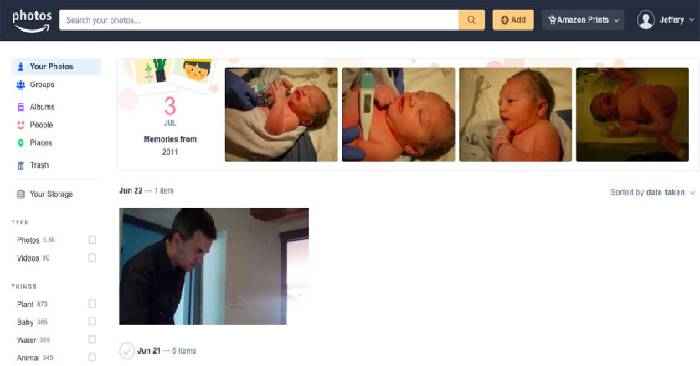In the age of Google Drive, Dropbox, and other mega cloud storage services, it’s easy to overlook another image hosting platform that’s right in front of you: Amazon Photos. The online retailer is well-known for selling nearly everything on the planet; however, its image-hosting capabilities are frequently overlooked. After using it for a while, our Amazon Photos review will look at the benefits and drawbacks of using the service to backup your image archive.
Having a proper photo storage platform for your image archive is more important than ever in the age of 4K video and 50-megapixel images. Photographers have dabbled in a variety of cloud storage options over the years, but buyouts and market changes have made it difficult to know where to store your photos. You don’t want to move your archive after you’ve built it up and created a taxonomy.
Amazon, which began as a bookseller, is now invading nearly every aspect of our lives, from smart speakers to original television content. However, one of Amazon’s many services that don’t always get the attention it deserves is its photo storage capability.
How do I store my photos on Amazon Prime?
Your photos can be stored on Amazon Prime Photos or Amazon Cloud Drive. Both platforms are included with your Prime membership and provide incredible value for photographers looking to back up a large archive.
How much photo storage do I get with Amazon Prime?
Amazon Photos provides Prime members with unlimited photo storage. These members can invite up to five friends or family members, who will also receive unlimited photo storage in Amazon Photos’ Family Vault.
Amazon Drive, which provides 5GB of storage for videos and other content, is also included with your Prime membership. According to our reviews of this and other services, that’s a very good deal for the price of a Prime subscription. But we’re digressing.
Amazon Prime has many advantages, but for photographers, the unlimited photo storage that comes free with a Prime membership is unrivaled in the marketplace. Flickr, too, has a terabyte storage limit for its users.
What is the difference between Amazon Photos and Amazon Drive?
Amazon Prime can be used for photo storage in two ways: Amazon Photos and Amazon Drive. Consider it in terms of a website to better understand the distinction. Amazon Drive functions similarly to a content management system (CMS) – the back end where you upload and manage files. The front end, the public-facing site where you can see the fruits of your labor in all their glory, is Amazon Photos.
Amazon Photos will also display your images. However, Amazon Drive can also store your music files, Word documents, PDFs, and other files. The drive is more of a platform for asset management. Prime Photos is more of a gallery than a search engine.
Amazon Photos and Amazon Cloud Drive both provide unlimited photo storage. However, you are limited to 5GB for all other files, including videos. If you go over that limit, you’ll need to buy more storage for those files.
In our ongoing Amazon Photos review, we found that the limitations can be inconvenient if you rarely shoot video and are slightly over the limit. However, the expansion cost isn’t prohibitively expensive, and if you intend to shoot more video in the future, it’s well worth it.
Note: If you want to make some adjustments to the photo just let me know. I can do it for you at a very low cost. You can hire me to edit your photo.
Family Vault

What is the Amazon Photos’ Family Vault?
Essentially, it’s a simple way to share your photos with other members of your family. It works by allowing you to connect all of your Amazon Prime Photo accounts in the household so that there is a single repository for all of your images that everyone can access. Similar to a family photo album, but much larger and, thankfully, searchable, so you can easily find the images you want.
To get started, simply send an invite to the other members of your family, and once they accept the invite, they will be able to access the Family Vault.
It can then be used by selecting and uploading images to your Amazon Photos and then selecting a selection to add to the Family Vault.
This means you can keep your private photo library in addition to the one that the rest of the family can access.
Is Amazon Photos free for Prime members?
Yes, if you have Amazon Prime, Prime Photos is ‘free.’ But, since you’re paying £7.99 / $12.99, “free” really means “within the terms of your subscription.”
Uploading images to Amazon Photos and Amazon Drive

Amazon makes it very simple for photographers to back up their images. Uploading to Amazon Photos and Drive is possible using desktop clients for both Mac and Windows computers.
Upload clients are also available for iOS and Android devices, as well as Amazon’s own Fire devices.
Uploading to Amazon Photos and Amazon Drive can be done via drag-and-drop.
Drag-and-drop is available for uploading to Amazon Photos and Amazon Drive.
It should be noted that Amazon’s photo upload clients do not support syncing or automated backups. However, apps like Syncovery now offer Amazon Drive as an option for automated file synchronisation.
Amazon Photos Metadata
Amazon Photos adds some metadata to your images, but not much. The camera name, shutter speed and aperture, date and time the photo was taken, file name, file size, and resolution are all displayed in the EXIF data of your images.
Other platforms may offer a more comprehensive list of EXIF data, such as ISO and White Balance values, but Prime Photos’ offering is more than adequate for basic photo storage and archive management.
Amazon Prime members get unlimited photo storage, as well as 5 GB of storage for videos, documents, and other files. They can also invite up to five friends or family members to receive unlimited photo storage and to collect photos in the Family Vault together.
To view an image’s metadata, click the little I icon in the upper right corner.
Sharing images from Amazon Photos
You can share your images from Prime Photos, but your options are limited. However, if you’re just looking to back up your archive, you’ll find all the sharing features you’ll need.
You can send Prime Photos to friends and family via Facebook, email, or a direct link to the image. You can also upload photos to Family Vaults or form groups of other Prime members and invite them to view your images.
What happens to my photos when I cancel Amazon Prime?
This is the major drawback to having unlimited photo storage. When you cancel or let your Amazon Prime subscription expire, you revert to the free plan, which only provides 5GB of storage space. According to Amazon:
We may delete or restrict access to Your Files if you exceed the storage limit of your Service Plan, including by downgrading or not renewing your Service Plan or no longer qualifying for an Additional Benefit. We reserve the right to impose additional restrictions on the Service’s use.
This implies that Amazon may delete or restrict your access to your files. Rather than deleting them the moment you miss a Prime payment, Amazon will most likely offer you the opportunity to return to Prime and regain access.
However, if you decide Prime isn’t for you and want to move your archive, it’s worth downloading your photos and other files first before canceling your membership.
Amazon Photos review for professionals
Can professional photographers use Amazon Prime Photos and Amazon Cloud Drive? Both yes and no. It’s easy to use as a photo storage platform and archival management tool, and it’s a great value with unlimited image storage.
However, if you intend to use Amazon Prime for more than just photo storage, you should think twice. Professional photographers may seek an asset management platform that allows them to share images with clients and even sell photos directly, as 500px has recently enabled.
This is not permitted by Amazon Prime. Amazon makes it clear in the terms that your files are intended for personal use only and should not be used for commercial purposes.
Will Amazon now be able to tell the difference between sending a link to a Prime Photos gallery to a client and your mother? Most likely not. But the point is that there is no simple way for your client to buy directly from Amazon Cloud Drive or Prime Photos.
Clients would have to provide you with file names and send you a PayPal payment, which is inconvenient and unprofessional. So, if you want to sell images directly from your archive, Prime Photos and Amazon Cloud Drive may not be the best option.
If you shoot for fun, or if you want to archive a large collection of images as a backup or to share with family, Amazon Prime photo storage is one of the most user-friendly and cost-effective options available.
Amazon Photos Storage for videographers
Here’s where self-awareness comes into play. If you only shoot stills, Prime Photos Storage is fantastic and well worth the money. Even if you only shoot stills on occasion, Amazon Prime Photos Storage is still worth the money, even if you occasionally need to pay for extra video storage.
However, if you primarily shoot video, Prime Photos Storage is not for you. The title gives the game away! Vimeo Pro is, in our opinion, the best value platform for videographers.
Note: If you want to make some adjustments to the photo just let me know. I can do it for you at a very low cost. You can hire me to edit your photo.
LATEST POST
- What is Midjourney
 Discover the capabilities of Midjourney AI, learn how to effectively utilize the platform, and explore the advantages and disadvantages of the Midjourney AI image generator across its different pricing options.
Discover the capabilities of Midjourney AI, learn how to effectively utilize the platform, and explore the advantages and disadvantages of the Midjourney AI image generator across its different pricing options. - Brand identity elements
 In the vast marketing universe, imagery is pivotal in establishing and nurturing a brand’s identity. A brand’s visual choices are not merely aesthetic decisions but strategic moves that can significantly influence perception and performance. This Picfixs article explores the intricacies of selecting imagery that complements and enhances a brand’s essence, ensuring it resonates with the… Read more: Brand identity elements
In the vast marketing universe, imagery is pivotal in establishing and nurturing a brand’s identity. A brand’s visual choices are not merely aesthetic decisions but strategic moves that can significantly influence perception and performance. This Picfixs article explores the intricacies of selecting imagery that complements and enhances a brand’s essence, ensuring it resonates with the… Read more: Brand identity elements - 100 Best Mountain Captions and Mountain Quotes for Instagram
 Ready to scale new social media heights? Look no further than this treasure trove of 100 exhilarating captions and quotes, handpicked for your Instagram mountain posts!
Ready to scale new social media heights? Look no further than this treasure trove of 100 exhilarating captions and quotes, handpicked for your Instagram mountain posts! - Symmetry in Photography: A Creative Approach with Examples
 Delve into the enchanting realm of symmetry in photography as we showcase mesmerizing examples on our website. Experience the allure of perfectly mirrored images!
Delve into the enchanting realm of symmetry in photography as we showcase mesmerizing examples on our website. Experience the allure of perfectly mirrored images! - 11 Quarantine Photoshoot Ideas to Try at Home for Amazing Photos
 Looking for unique photoshoot ideas during quarantine? Explore the 11 creative suggestions that will help you capture unforgettable moments at home.
Looking for unique photoshoot ideas during quarantine? Explore the 11 creative suggestions that will help you capture unforgettable moments at home.


